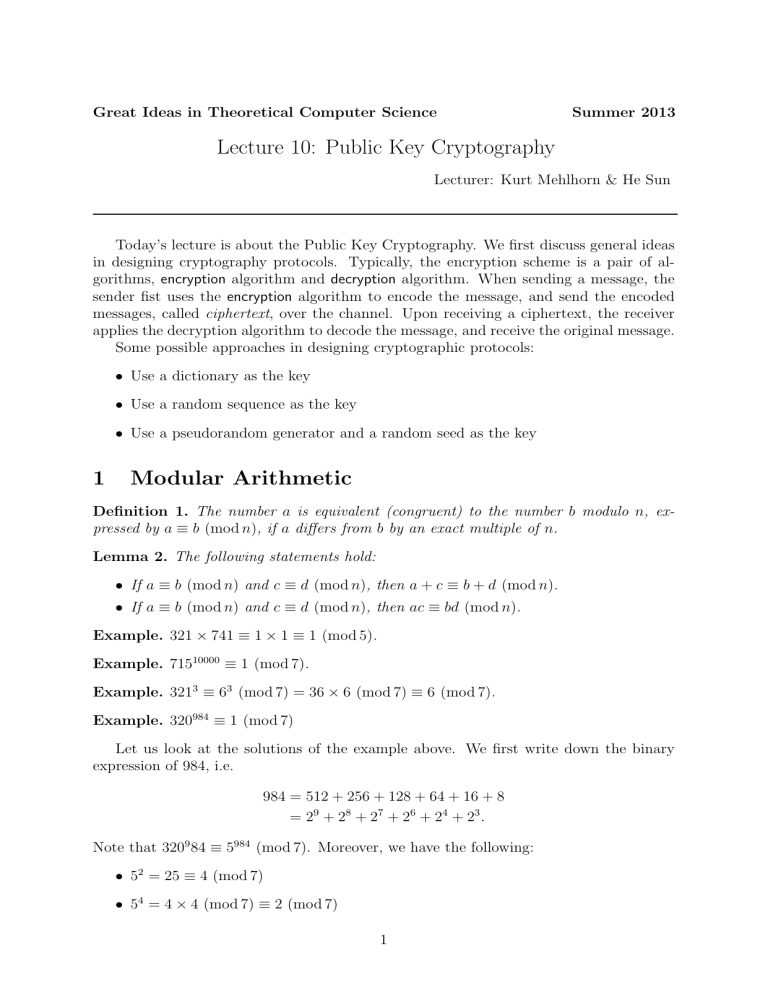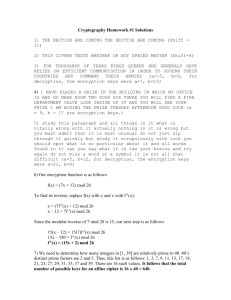Lecture Notes

Great Ideas in Theoretical Computer Science Summer 2013
Lecture 10: Public Key Cryptography
Lecturer: Kurt Mehlhorn & He Sun
Today’s lecture is about the Public Key Cryptography. We first discuss general ideas in designing cryptography protocols. Typically, the encryption scheme is a pair of algorithms, encryption algorithm and decryption algorithm. When sending a message, the sender fist uses the encryption algorithm to encode the message, and send the encoded messages, called ciphertext , over the channel. Upon receiving a ciphertext, the receiver applies the decryption algorithm to decode the message, and receive the original message.
Some possible approaches in designing cryptographic protocols:
• Use a dictionary as the key
• Use a random sequence as the key
• Use a pseudorandom generator and a random seed as the key
1 Modular Arithmetic
Definition 1.
The number a is equivalent (congruent) to the number b modulo n , expressed by a ≡ b (mod n ) , if a differs from b by an exact multiple of n .
Lemma 2.
The following statements hold:
• If a ≡ b (mod n ) and c ≡ d (mod n ) , then a + c ≡ b + d (mod n ) .
• If a ≡ b (mod n ) and c ≡ d (mod n ) , then ac ≡ bd (mod n ) .
Example.
321 × 741 ≡ 1 × 1 ≡ 1 (mod 5) .
Example.
715
10000 ≡ 1 (mod 7) .
Example.
321
3 ≡ 6
3
(mod 7) = 36 × 6 (mod 7) ≡ 6 (mod 7) .
Example.
320
984 ≡ 1 (mod 7)
Let us look at the solutions of the example above. We first write down the binary expression of 984, i.e.
984 = 512 + 256 + 128 + 64 + 16 + 8
= 2
9
+ 2
8
+ 2
7
+ 2
6
+ 2
4
+ 2
3
.
Note that 320 9 84 ≡ 5 984 (mod 7). Moreover, we have the following:
• 5 2 = 25 ≡ 4 (mod 7)
• 5 4 = 4 × 4 (mod 7) ≡ 2 (mod 7)
1
• 5 8 = 2 × 2 (mod 7) ≡ 4 (mod 7)
• 5 16 = 4 × 4 (mod 7) = 2 (mod 7)
• 5 32 ≡ 4 (mod 7)
• 5 64 ≡ 2 (mod 7)
• 5 128 ≡ 4 (mod 7)
• 5 256 ≡ 2 (mod 7)
• 5 512 ≡ 4 (mod 7)
Hence
5
984
= 5
512+256+128+64+16+8
(mod 7)
≡ 4 × 2 × 4 × 2 × 2 × 2 × 4 (mod 7)
≡ 1 (mod 7)
2 Fermat’s Little Theorem
We call that n is divisible by m if n = km .
Theorem 3 (Fermat’s Little Theorem) .
If p is a prime number, then a p all a .
≡ a (mod p ) for
An alternative formulation of the Fermat’s Little Theorem is as follows: If p is a prime number and a is any integer not divisible by p , then a p − 1 ≡ 1 (mod p ).
Definition 4.
If ab ≡ 1 (mod m ) , then b is called the multiplicative inverse of a modulo m .
3 The Euclidean Algorithm
Given two integers r
0 of r
0 and r
1 and r
1
, the Euclidean Algorithm finds the greatest common divisor
, denoted by gcd( r
0
, r
1
).
Before present the algorithm, we first look at the following lemma.
Lemma 5.
gcd( r
0
, r
1
) = gcd( r
1
, r
0 mod r
1
)
Theorem 6 (The Euclidean Algorithm) .
Given two integers 0 < b < a , we make a repeated application of the division algorithm to obtain a series of division equations, which eventually terminate with a zero remainder: a = bq
1
+ r
1
, 0 < r
1
< b b = r
1 q
2
+ r
2
, 0 < r
2
< r
1
· · · r j − 2
= r j − 1 q j
+ r j
, 0 < r j
< r j − 1 r j − 1
= r j q j +1
The greatest common divisor gcd( a, b ) of a and b is r j
, the last nonzero remainder in the division process.
2
Now we show that the Euclidean Algorithm can be used to compute a multiplicative inverse.
Definition 7.
If ab ≡ 1 (mod p ) , then b is called the multiplicative inverse of a module p .
Theorem 8 (Multiplicative Inverse Algorithm) .
Given two integers 0 < b < a , consider the Euclidean Algorithm equations which yield gcd( a, b ) = r j
. Rewrite all of these equations except the last one, by solving for the remainders: r
1
= a − bq
1 r
2
= b − r
1 q
2 r
3
= r
1
− r
2 q
3
· · · r j − 1
= r j − 3
− r j − 2 q j − 1 r j
= r j − 2
− r j − 1 q j
Then, in the last of these equations, r j
= r j − 2
− r j − 1 q j
, replace r j − 1 with its expression in terms of r j − 3 and r j − 2 from the equation immediately above it. Continue this process successively, replacing r j − 2
, r j − 3
, · · · , until we obtain the final equation r j
= ax + by, where x and y are integers. In the special case that gcd( a, b ) = 1 , the integer equation reads
1 = ax + by.
Therefore we deduce
1 ≡ by mod a so that the residue of y is the multiplicative inverse of b , mod a.
4 The RSA Algorithm
• p, q are two prime numbers
• Let n = p · q
• Pick a positive integer r that has no common factor with ( p − 1) · ( q − 1)
• Find a multiplicative inverse of r modulo ( p − 1) · ( q − 1), i.e. we find a number s such that rs ≡ 1 (mod ( p − 1) · ( q − 1))
Encryption: We need to know n, r . Assume that the message is x ≤ n . Let y , x r
(mod n ) .
The pair of values n, r are public encryption key . This information is publicly available, and anyone can compute y if they are given x .
3
Decryption: To decrypt, you need to know s , the private decryption key . With the value of s , you simply compute z , y s
(mod n ) ≡ x rs ≡ x (mod n ) .
That is, you need to know s to decrypt. Now s is the multiplicative inverse of r modulo
( p − 1)( q − 1). The outsiders know r , and if they knew ( p − 1)( q − 1), then it would be easy (with the Euclidean Algorithm) to compute s . But they do not know ( p − 1)( q − 1).
They know n , which is equal to pq , but they do not have n factored into p and q . To find ( p − 1)( q − 1), they need to know the prime factors p and q of n , and factoring large numbers is not easy.
4








